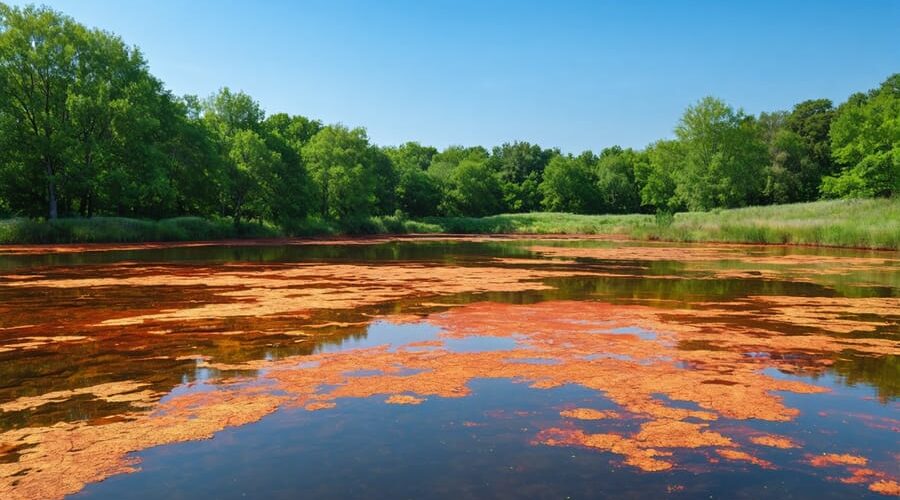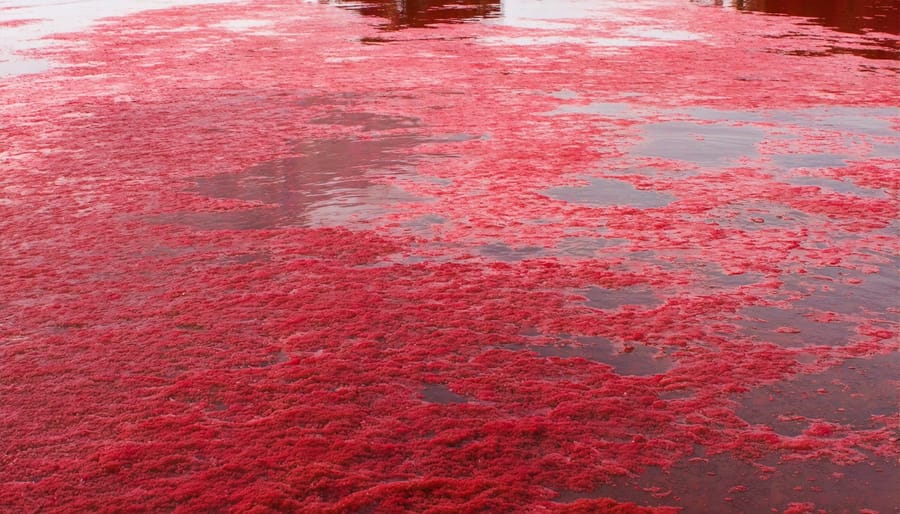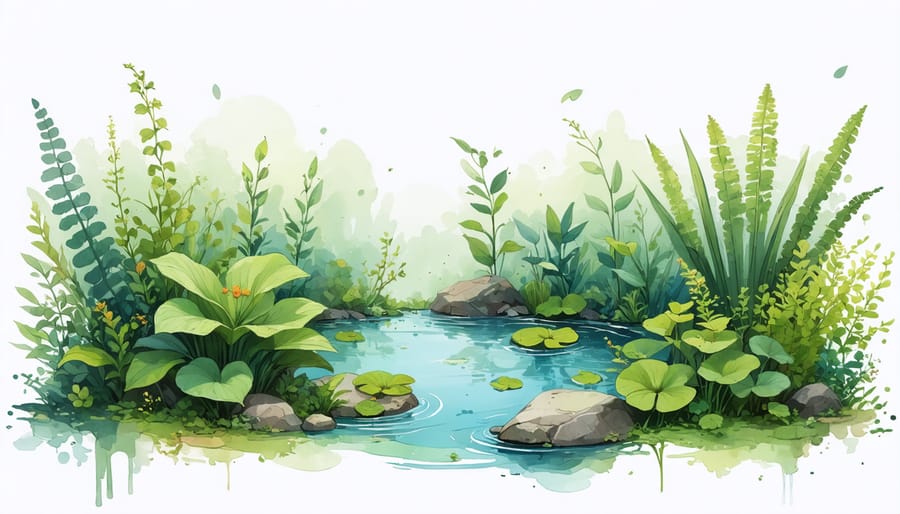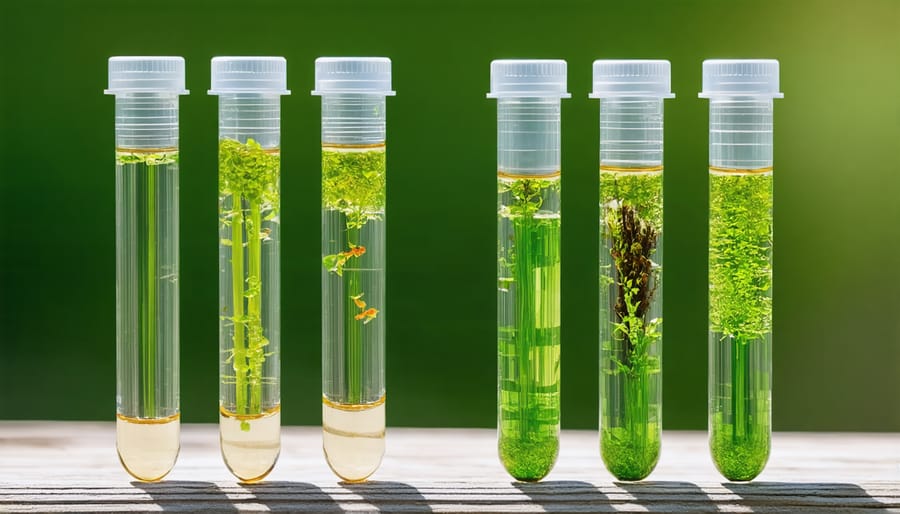
Red Algae Taking Over Your Pond? Here’s How to Restore Balance
Red algal blooms transform pristine ponds into murky, crimson nightmares – but don’t panic. These dangerous microscopic organisms, while alarming, can be effectively managed with the right approach. When water temperatures rise and excess nutrients build up, certain species of algae multiply explosively, creating those distinctive red or rust-colored patches that spell trouble for pond ecosystems. Beyond their unsightly appearance, these blooms can deplete oxygen levels, harm fish populations, and even produce toxins harmful to pets and wildlife.
The good news? With proper understanding and swift action, you can both prevent and treat red algal blooms in your pond. Whether you’re currently dealing with an outbreak or wanting to protect your water feature, this guide will walk you through practical, proven strategies to maintain crystal-clear water. From immediate intervention techniques to long-term prevention methods, we’ll cover everything you need to know about keeping your pond healthy and algae-free.
Let’s dive into the essential steps for identifying, controlling, and preventing these troublesome blooms, ensuring your pond remains the beautiful, thriving ecosystem you envision.
Understanding Red Algal Blooms in Your Pond
Common Triggers for Red Algae Growth
Red algae thrive when specific environmental conditions align, making it important for pond owners to understand these triggers. The most common catalyst is excessive nutrients in the water, particularly phosphates and nitrates. These nutrients often come from decomposing plant matter, uneaten fish food, or runoff from nearby fertilized areas.
Sunlight plays a crucial role in red algae growth. Long periods of bright, direct sunlight combined with warm water temperatures (typically above 68°F or 20°C) create ideal conditions for algal blooms. This is why blooms are more common during summer months or in ponds with little natural shade.
Poor water circulation is another significant factor. Stagnant areas in your pond become perfect breeding grounds for red algae. This often occurs in corners or behind decorative features where water movement is limited. Additionally, inconsistent or inadequate filtration can allow nutrients to build up, further encouraging algae growth.
Changes in water chemistry can also trigger blooms. Sudden shifts in pH levels, often caused by heavy rainfall or improper chemical treatments, can stress beneficial bacteria that normally help keep algae in check. High carbon dioxide levels, combined with warm temperatures, can accelerate algae reproduction.
Being aware of these triggers helps pond owners take preventive action before red algae become a serious problem. Regular monitoring of water conditions and maintaining proper pond balance are key to preventing unwanted blooms.

Signs Your Pond is at Risk
Spotting potential algal bloom issues early can save your pond from becoming overwhelmed. Keep an eye out for excess nutrient warning signs that typically appear before a full-blown algae problem develops.
The first tell-tale sign is usually a slight green tinge to your water, especially during warm, sunny days. Watch for any unusual cloudiness or murky appearance that wasn’t there before. You might also notice your pond water becoming warmer than usual, as higher temperatures create perfect conditions for algae growth.
Pay attention to your fish’s behavior too! If they’re gasping at the surface more frequently or seem less active than normal, your pond might be heading toward trouble. Another red flag is rapid plant growth, particularly in floating plants or those near the water’s surface.
Check your pond’s edges for slimy film or reddish-brown patches starting to form. These early signs often appear before the characteristic red coloration takes hold. If you notice any of these warning signs, it’s time to take action before the situation worsens.
Natural Prevention Strategies

Beneficial Plants That Combat Algae
Nature provides some amazing natural algae control methods through aquatic plants that compete with algae for nutrients. Water lilies are fantastic allies in the fight against algae, as their broad floating leaves shade the water and reduce sunlight penetration. They’re not just beautiful – they’re hard workers too!
Hornwort is another superstar plant that absorbs excess nutrients like nitrogen and phosphorus, literally starving algae of its food source. This plant grows quickly and can be either floating or planted, making it super versatile for any pond setup.
Don’t overlook the power of marsh marigold and iris plants along your pond’s edges. These marginal plants not only create a lovely border but also act as natural filters, removing nutrients from the water before they can feed problematic algae.
For underwater coverage, consider adding some oxygenating plants like anacharis or Canadian pondweed. These plants release oxygen during the day and help maintain healthy water conditions that discourage algae growth.
My personal favorite is the water hyacinth – it’s like nature’s vacuum cleaner! These floating plants have extensive root systems that absorb huge amounts of nutrients. Just remember to control their growth, as they can spread quickly in warm conditions.
For smaller ponds, try adding some bog plants like cattails or rushes. They’re excellent at filtering water and create natural habitats for beneficial insects that help maintain your pond’s ecosystem. Remember to plant them in special aquatic baskets to keep their growth in check while they work their magic against algae.
Creating the Perfect Plant-to-Water Ratio
Finding the right balance between plants and water surface area is crucial for preventing red algal blooms in your pond. As a general rule, aim to cover 40-60% of your water surface with a mix of floating and submerged plants. This coverage allows for proper pond aeration while maintaining enough plant life to compete with algae for nutrients.
Start by dividing your pond into zones. Dedicate about 20% to floating plants like water lilies or lotus, which provide shade and reduce water temperature. Another 20-30% should contain submerged oxygenating plants such as hornwort or anacharis. Leave the remaining surface area open for proper gas exchange and visual appeal.
For every 50 square feet of pond surface, include:
– 2-3 floating plants
– 3-4 bunches of oxygenating plants
– 2-3 marginal plants along the edges
Monitor your plant growth monthly during the growing season. If plants become overcrowded, thin them out to maintain the ideal ratio. Remember that young plants will need space to spread, so initially plant them with room to grow. This balanced approach helps create a self-sustaining ecosystem that naturally resists algal blooms while keeping your pond looking beautiful and healthy.
Maintaining Healthy Water Chemistry
Key Water Parameters to Monitor
When dealing with red algal blooms, keeping a close eye on your pond’s water chemistry fundamentals is absolutely essential. The key parameters you’ll want to monitor regularly include pH, dissolved oxygen, nitrogen levels, and phosphate concentrations.
Your pond’s pH should typically stay between 6.5 and 8.2. When pH levels swing too far in either direction, it can create perfect conditions for algae to thrive. A simple digital pH meter or test strips can help you keep track of this important measurement.
Dissolved oxygen is another crucial factor – aim for levels above 6 mg/L. Low oxygen levels often trigger algal blooms, especially during warmer months. Consider adding an aerator if your readings consistently fall below this threshold.
Keep a close eye on nitrogen compounds, particularly ammonia and nitrates. High levels of these nutrients are like fertilizer for algae! Regular testing can help you catch problems before they get out of hand. Ideal ammonia levels should be near zero, while nitrates should stay below 10 ppm.
Phosphate levels are perhaps the most important measurement of all. Even tiny amounts (above 0.02 ppm) can fuel aggressive algae growth. Test for phosphates weekly during warm seasons and take action immediately if levels start to rise.

Simple Testing and Adjustment Methods
Testing your pond water doesn’t have to be complicated or expensive. Start with simple test strips, available at most garden centers, which can measure key parameters like pH, nitrates, and phosphates in seconds. Dip the strip in your pond water and compare the colors to the chart – it’s that easy!
For a quick visual check, use the white disk test. Lower a white object (like a plastic lid) into your pond until it disappears from view. If you can’t see it beyond 18 inches deep, your water likely has excess algae. Make a habit of doing this weekly to track changes in water clarity.
Keep a simple logbook to record your readings and observations. Note weather conditions, feeding schedules, and any water treatments you’ve applied. This helps identify patterns and triggers for algal blooms.
If you spot early signs of red algae, try this basic adjustment method: Reduce fish feeding temporarily and remove visible algae with a pond net. Then perform a partial water change (about 15-20%) using dechlorinated water. Many pond owners find success with this gentle approach.
For ongoing maintenance, create a basic testing schedule: weekly in warm months and monthly in cooler seasons. Remember, prevention through regular testing is much easier than dealing with a full-blown algal bloom!
Emergency Response Plan
Immediate Actions to Take
When you spot red algae in your pond, quick action is essential to prevent it from taking over. Start by removing as much visible algae as possible using a pond net or rake – be gentle to avoid stirring up too much sediment. After physical removal, perform a 25% water change to dilute the remaining algae and reduce nutrient levels.
Next, test your water parameters immediately, paying special attention to phosphate and nitrate levels. If these are high, use a phosphate remover to bring them down quickly. Consider adding beneficial bacteria products that compete with algae for nutrients – they’re natural and safe for your pond life.
Install a temporary shade cloth over your pond to reduce sunlight exposure, as this helps slow algae growth while you work on long-term solutions. If you have a UV clarifier, make sure it’s clean and functioning properly, or install one if you don’t have one yet.
For immediate oxygen support, add an air pump or fountain if possible. This helps maintain healthy oxygen levels for your fish while fighting the algae. Avoid using algaecides as a first response – they can cause more problems by releasing toxins when the algae die off suddenly.
Remember to remove any dead leaves or debris around the pond, as these contribute to the problem. Keep monitoring your water quality daily until the situation improves.
Long-term Recovery Strategies
For lasting control of red algae in your pond, focus on creating a balanced ecosystem that naturally resists algae growth. Start by installing a proper biological filtration system that includes both mechanical and biological filtering components. This investment pays off by maintaining cleaner water year-round.
Consider adding more aquatic plants to your pond, aiming for coverage of about 60-70% of the water surface. Water lilies, lotus, and submerged plants like hornwort not only compete with algae for nutrients but also create shade that inhibits algae growth. Plus, they add beautiful visual interest to your water garden!
Regular maintenance is key to long-term success. Establish a routine that includes testing water parameters monthly, cleaning filters as needed, and removing debris before it can decompose. Many pond owners find success with quarterly deep cleanings to prevent nutrient buildup.
Natural solutions like barley straw or beneficial bacteria treatments can help maintain water quality without harsh chemicals. These work gradually but provide sustainable results. Remember to be patient – lasting changes take time to establish.
Consider upgrading your pond’s design if problems persist. Adding a deeper section (at least 2-3 feet) provides cooler water zones that discourage algae growth. Installing additional aeration through fountains or air pumps helps maintain healthy oxygen levels while creating beautiful water features.
Keeping your pond healthy and free from red algal blooms doesn’t have to be a constant struggle. By implementing the prevention strategies we’ve discussed, you can maintain crystal-clear water and a thriving ecosystem. Remember to start with proper pond design, including adequate filtration and the right balance of plants. Regular maintenance, while it may seem time-consuming, is actually your best defense against algal problems.
Make it a habit to test your water parameters weekly, especially during warmer months when algae are most active. Keep an eye on nutrient levels and remove debris before it can decompose and feed unwanted algae growth. If you’re adding new plants or fish, introduce them gradually to maintain your pond’s delicate balance.
Most importantly, don’t wait for problems to develop – take action now to protect your pond. Start by reducing fish feeding if needed, adding more floating plants, or installing that UV clarifier you’ve been considering. Every small step makes a difference in preventing red algal blooms.
Create a monthly maintenance schedule and stick to it. Your pond will reward you with clearer water, healthier fish, and more enjoyable outdoor living space. Remember, a well-maintained pond isn’t just beautiful – it’s a testament to your dedication as a water gardener. With these strategies in hand, you’re well-equipped to keep red algal blooms at bay and enjoy your water feature for years to come.
